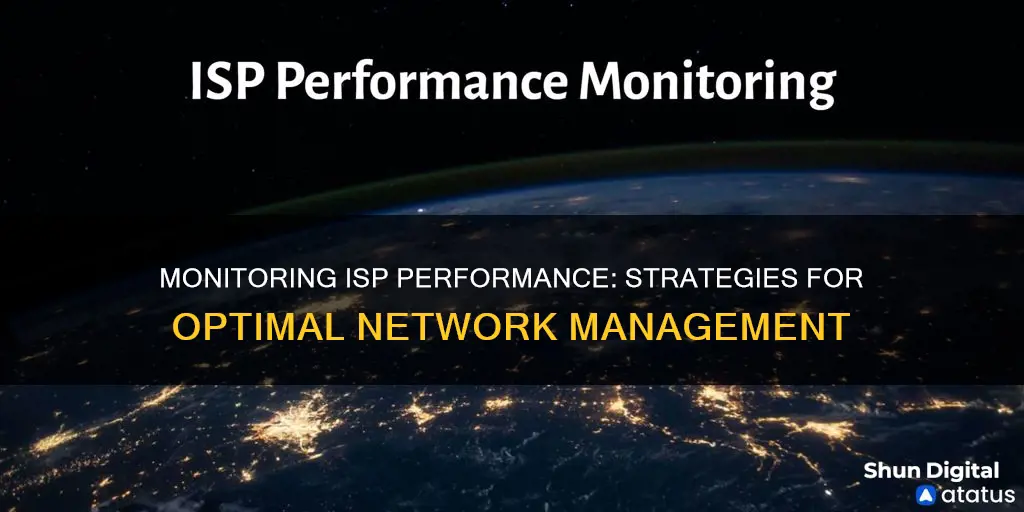
Monitoring the performance of your Internet Service Provider (ISP) is essential to ensure you are getting the level of service you are paying for. There are a number of tools available to help you do this, such as Ookla’s Speedtest CLI, Netdata, Smokeping, and ThousandEyes. These tools can help you monitor metrics such as download and upload speed, packet loss, latency, and jitter. By using these tools, you can identify any issues with your ISP's performance and hold them accountable to deliver the service they promised.
| Characteristics | Values |
|---|---|
| Tools | Smokeping, Speedtest CLI, Netdata, ThousandEyes, Obkio, Home Assistant, Pingwatch, Telegram, Grafana, Prometheus, Grafana, Speedtest-tracker, EMCO Ping Monitor, AppDynamics |
| Metrics | Packet Loss, Latency, Jitter, Bytes Consumed, Bandwidth Utilization, Uptime, Mean Opinion Score, Throughput, Error Rates, Quality of Service, DNS Resolution Time, etc. |
| Benefits | Proactive Issue Detection, Elevating ISP Network Reliability, ISP Network Efficiency Optimization, Comprehensive Reporting, Instant Network Alerts, Informed Decision-Making, etc. |
What You'll Learn

Utilise speed tests
Speed tests are a great way to ensure you are getting the internet speeds you are paying for. They are also useful for identifying any issues with your connection and can help you hold your ISP accountable if they are not delivering the service they promised.
There are a number of online speed tests available, such as Ookla's Speedtest, Fast.com, M-Lab Internet Speed Test, Speedof.me, and Testmy.net. These tests can measure your download speed, upload speed, and latency (or "ping"). Some tests, like Ookla's, also measure packet loss and network jitter.
It is a good idea to run speed tests at different times of the day and on different devices, as speeds can vary depending on the time of day and the device being used. If you are testing a Wi-Fi connection, you should also run tests at varying distances from your router, as the further away you are, the slower your speeds will be.
If you find that your internet speeds are consistently slower than what you are paying for, you can contact your ISP to discuss the issue.
Volkswagen's Blind Spot Monitoring: What You Need to Know
You may want to see also

Monitor packet loss
Monitoring packet loss is an important aspect of maintaining a reliable internet connection. Packet loss occurs when data packets fail to reach their destination, leading to sluggish or unresponsive connections. To monitor and address this issue, several tools and techniques are available:
Online Speed Tests
While online speed tests are a simple way to check internet performance, they may not provide consistent or detailed results. One-off tests may not capture intermittent packet loss issues, so continuous monitoring is necessary.
Ping Utility
The ping utility is a common tool for testing network connectivity and responsiveness. By sending a series of packets to a specified destination, it can measure packet loss by displaying the percentage of lost packets. This helps identify potential issues with the connection.
Network Monitoring Tools
Various network monitoring tools, such as ThousandEyes, Netdata, PRTG, and SolarWinds' Network Performance Monitor, can help identify and address packet loss. These tools offer features like hop-by-hop packet path maps, auto-discovery of connected devices, and alerts for potential issues.
ISP Latency Monitoring
Monitoring ISP latency can provide metrics like latency, jitter, and hop count. However, it may not offer specific packet loss data, making it challenging to set up notifications for packet loss thresholds.
Traceroute
Using the traceroute command can help identify the specific path your data packets are taking. This information can be useful in pinpointing potential issues with specific routers or connections.
VPN Usage
Utilising a virtual private network (VPN) can help mitigate the impact of packet loss over the internet. VPNs employ encryption and other technologies to enhance the reliability and performance of network communications.
Upgrade Hardware and Optimise Configuration
Upgrading outdated network hardware and optimising configurations can also reduce packet loss. Ensuring adequate bandwidth allocation and quality of service (QoS) settings can improve the network's ability to handle data packets efficiently.
By employing these techniques and tools, you can effectively monitor and address packet loss issues, ensuring a more reliable and responsive internet connection.
Cutting Off Ankle Monitors: Criminal Action or Personal Freedom?
You may want to see also

Measure latency
Latency measures the time it takes for your device to receive a response after sending out a request. As internet speeds have increased, latency issues have become easier to spot. Latency is directly correlated with the quality of experience when using latency-sensitive applications like video calls, live streaming, and online gaming.
There are three distinct latency metrics that give a more fine-grained understanding of potential bottlenecks in the network:
- Idle Latency is measured at the beginning of a speed test while the network is relatively inactive.
- Download Latency is measured during the download test to see how it is affected by download activity on your network, such as a household member downloading a large game while you are working.
- Upload Latency is measured during the upload test to see how it is affected by upload activity on your network, such as someone uploading a year's worth of photos.
Ping and Traceroute are two latency tests that can be performed from your PC to test online, internet, and local network latency. Ping is the simplest approach, measuring the round trip time (RTT) between your PC and the target you specify (domain or IP address). This is the total latency to get a response from a server, PC, router, or internet site.
Ping has some limitations, including the possibility of ICMP packets being blocked by an intermediate firewall, or the ICMP protocol being handled with low priority by intermediate routers, which can distort accuracy. Additionally, ping measures the round trip delay, so it is not possible to detect directional network latency problems.
Traceroute is an alternative to ping, which uses the TTL (Time to Live) field of IP packets to discover intermediate routers between a source and destination. This technique tests the latency to each hop along the network path and identifies them by IP address. This provides more insight into the origin of network latency problems. Traceroute is easy to use and provides a representation of the network path. However, it also has limitations, including the possibility of routers not responding to ICMP packets for security reasons, and it only measures round trip latency.
More advanced synthetic latency testing techniques, such as OWAMP (One-Way Active Measurement Protocol) and TWAMP (Two-Way Active Measurement Protocol), get around the problems introduced by testing with low-priority ICMP packets and the limitation of round-trip latency measurements. These techniques provide more precise network latency measurements and can be used to detect latency problems in each direction independently.
Audio Monitoring: What Should Employers Disclose to Employees?
You may want to see also

Check for jitter
Jitter is the variation in the delay of network packet delivery, or the inconsistency in the time it takes for data packets to travel from one point to another in a network. It is typically measured in milliseconds (ms). Jitter can affect both wired and wireless networks and can be caused by several factors, such as congestion, network congestion, routing issues, hardware limitations, or fluctuations in network traffic.
To check for jitter, you can use a combination of active and passive monitoring techniques. Active monitoring involves generating synthetic traffic or test packets and monitoring their journey through the network. Passive monitoring, on the other hand, involves analyzing the flow of network traffic and extracting jitter measurements from the captured data.
One way to measure jitter is to use a tool like Ookla's Speedtest CLI, which is a developer-friendly Linux native command-line tool. This tool can be used to run speed tests and collect key ISP performance metrics, including jitter. By running speed tests and analyzing the results, you can identify if there are issues with jitter on your network.
Another method to check for jitter is to use a network performance monitoring tool such as Obkio. Obkio continuously monitors network performance and key metrics like network jitter to help you understand your network performance and identify and fix issues. Obkio sends synthetic data packets at regular intervals to capture any variations in delay or signs of network jitter.
Additionally, you can also check your device frequency as a high frequency can interfere with the connection and cause jitter. The standard frequency is 2.4 GHz, but if your device operates at a higher frequency, you may experience problems.
By using these tools and techniques, you can effectively check for jitter and identify any issues causing network instability or impacting the performance of real-time applications.
Evolution of Blind Spot Monitoring in Vehicles
You may want to see also

Analyse bandwidth
Analysing bandwidth is crucial to understanding your network's performance and ensuring a seamless online experience. Bandwidth refers to the capacity of a network to transfer data between devices or the internet within a given time frame. Here are some detailed instructions on how to analyse bandwidth:
Choose a Suitable Bandwidth Monitoring Tool:
Select a bandwidth monitoring tool that fits your needs. Examples include SolarWinds Observability Self-Hosted, PRTG Network Monitor, and NetData. Some tools are free, while others come with a price tag. Consider the size and complexity of your network, scalability, ease of use, reporting and alerting capabilities, and cost when making your choice.
Monitor Bandwidth Usage:
Use your chosen tool to monitor bandwidth usage across your network. This will help you identify which applications or devices are consuming the most bandwidth. By understanding bandwidth usage, you can make informed decisions about bandwidth management and optimise your network's performance.
Visualise Bandwidth Data:
Visualise the collected bandwidth data using graphs, charts, or other visual representations. This will help you identify trends, patterns, and anomalies in bandwidth usage over time. For example, you may notice spikes or dips in bandwidth usage during certain periods, which can help you optimise your network configuration.
Identify Bottlenecks and Latency Issues:
Analyse the data to identify any bottlenecks or latency issues in your network. Bottlenecks occur when a specific application or device is consuming excessive bandwidth, impacting the performance of other applications. Latency issues refer to delays in data transmission, which can be caused by various factors such as network congestion or faulty equipment.
Monitor Key Metrics:
Pay close attention to key metrics such as packet loss, latency, and jitter. Packet loss measures the percentage of data packets dropped during transmission, which can impact the quality of experience for users. Latency measures the time it takes for your device to receive a response after sending a request. Jitter refers to the variance in latency between data packets.
Take Action:
Based on your analysis, take appropriate actions to optimise your bandwidth usage and network performance. This may include adjusting your network configuration, moving your router to a more central location, or contacting your ISP to discuss any issues or concerns. By actively monitoring and analysing bandwidth, you can ensure a reliable and efficient online experience for yourself and other users.
Blind Spot Monitor vs Lane Departure Warning: What's the Difference?
You may want to see also
Frequently asked questions
You can use SmokePing to monitor connection quality over time. It periodically sends out a burst of packets and graphs the results.
Key metrics include speed, packet loss, latency, and jitter. Speed is the most obvious measure of ISP performance, while packet loss measures the percentage of packets dropped during the speed test. Latency measures how quickly your device gets a response after sending out a request, and jitter is the variance in latency between data packets.
ISP network monitoring offers several benefits, including proactive issue detection, improved network reliability, network efficiency optimization, efficient resource allocation, instant network alerts, and informed decision-making. It enables ISPs to identify and address potential problems early on, enhance customer satisfaction, and minimize revenue loss.







